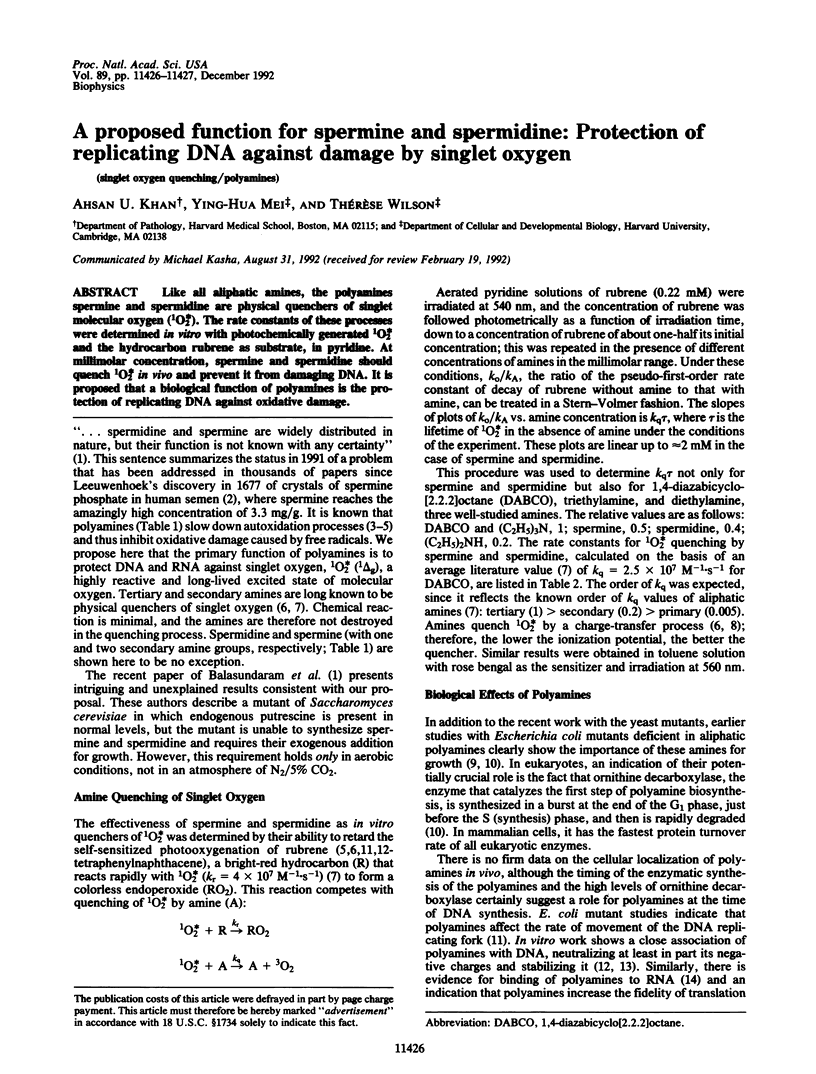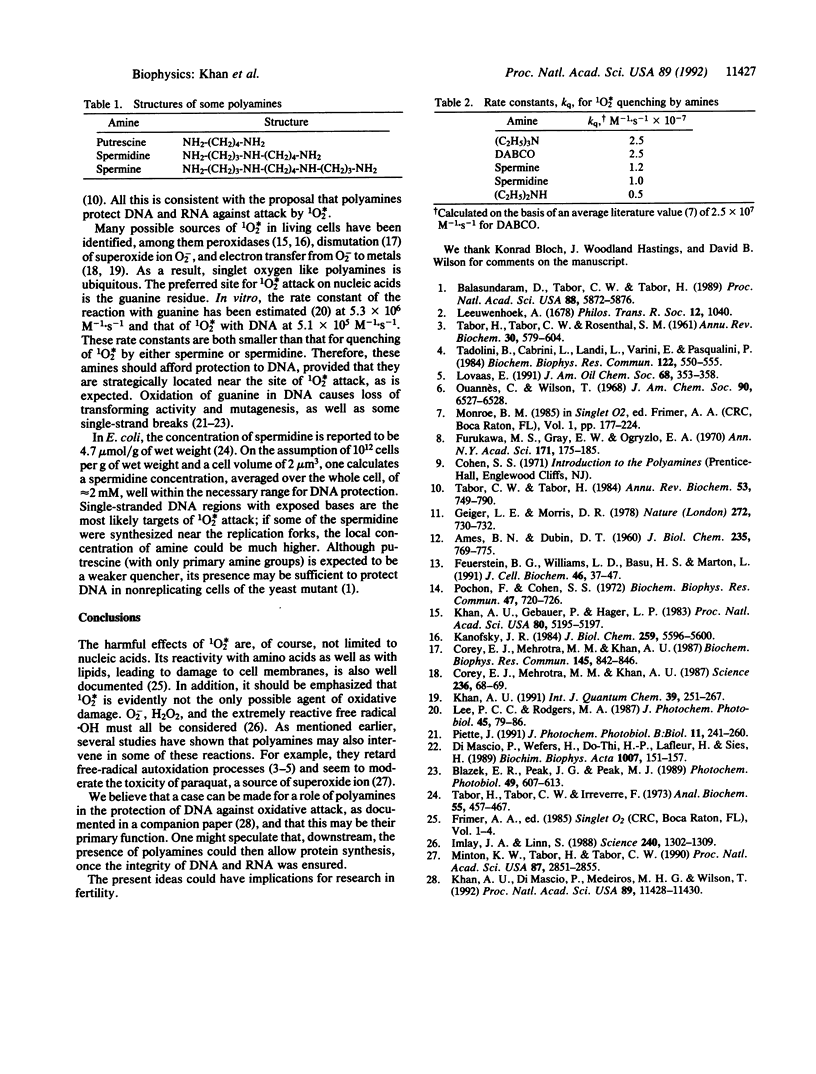Abstract
Like all aliphatic amines, the polyamines spermine and spermidine are physical quenchers of singlet molecular oxygen (1O2*). The rate constants of these processes were determined in vitro with photochemically generated 1O2* and the hydrocarbon rubrene as substrate, in pyridine. At millimolar concentration, spermine and spermidine should quench 1O2* in vivo and prevent it from damaging DNA. It is proposed that a biological function of polyamines is the protection of replicating DNA against oxidative damage.
Full text
PDF

Selected References
These references are in PubMed. This may not be the complete list of references from this article.
- AMES B. N., DUBIN D. T. The role of polyamines in the neutralization of bacteriophage deoxyribonucleic acid. J Biol Chem. 1960 Mar;235:769–775. [PubMed] [Google Scholar]
- Balasundaram D., Tabor C. W., Tabor H. Spermidine or spermine is essential for the aerobic growth of Saccharomyces cerevisiae. Proc Natl Acad Sci U S A. 1991 Jul 1;88(13):5872–5876. doi: 10.1073/pnas.88.13.5872. [DOI] [PMC free article] [PubMed] [Google Scholar]
- Blazek E. R., Peak J. G., Peak M. J. Singlet oxygen induces frank strand breaks as well as alkali- and piperidine-labile sites in supercoiled plasmid DNA. Photochem Photobiol. 1989 May;49(5):607–613. doi: 10.1111/j.1751-1097.1989.tb08431.x. [DOI] [PubMed] [Google Scholar]
- Corey E. J., Mehrotra M. M., Khan A. U. Antiarthritic gold compounds effectively quench electronically excited singlet oxygen. Science. 1987 Apr 3;236(4797):68–69. doi: 10.1126/science.3563489. [DOI] [PubMed] [Google Scholar]
- Corey E. J., Mehrotra M. M., Khan A. U. Water induced dismutation of superoxide anion generates singlet molecular oxygen. Biochem Biophys Res Commun. 1987 Jun 15;145(2):842–846. doi: 10.1016/0006-291x(87)91041-2. [DOI] [PubMed] [Google Scholar]
- Di Mascio P., Wefers H., Do-Thi H. P., Lafleur M. V., Sies H. Singlet molecular oxygen causes loss of biological activity in plasmid and bacteriophage DNA and induces single-strand breaks. Biochim Biophys Acta. 1989 Mar 1;1007(2):151–157. doi: 10.1016/0167-4781(89)90033-x. [DOI] [PubMed] [Google Scholar]
- Feuerstein B. G., Williams L. D., Basu H. S., Marton L. J. Implications and concepts of polyamine-nucleic acid interactions. J Cell Biochem. 1991 May;46(1):37–47. doi: 10.1002/jcb.240460107. [DOI] [PubMed] [Google Scholar]
- Geiger L. E., Morris D. R. Polyamine deficiency reduces the rate of DNA replication fork movement in Escherichia coli. Nature. 1978 Apr 20;272(5655):730–732. doi: 10.1038/272730a0. [DOI] [PubMed] [Google Scholar]
- Imlay J. A., Linn S. DNA damage and oxygen radical toxicity. Science. 1988 Jun 3;240(4857):1302–1309. doi: 10.1126/science.3287616. [DOI] [PubMed] [Google Scholar]
- Kanofsky J. R. Singlet oxygen production by chloroperoxidase-hydrogen peroxide-halide systems. J Biol Chem. 1984 May 10;259(9):5596–5600. [PubMed] [Google Scholar]
- Khan A. U., Di Mascio P., Medeiros M. H., Wilson T. Spermine and spermidine protection of plasmid DNA against single-strand breaks induced by singlet oxygen. Proc Natl Acad Sci U S A. 1992 Dec 1;89(23):11428–11430. doi: 10.1073/pnas.89.23.11428. [DOI] [PMC free article] [PubMed] [Google Scholar]
- Khan A. U., Gebauer P., Hager L. P. Chloroperoxidase generation of singlet Delta molecular oxygen observed directly by spectroscopy in the 1- to 1.6-mum region. Proc Natl Acad Sci U S A. 1983 Sep;80(17):5195–5197. doi: 10.1073/pnas.80.17.5195. [DOI] [PMC free article] [PubMed] [Google Scholar]
- Lee P. C., Rodgers M. A. Laser flash photokinetic studies of rose bengal sensitized photodynamic interactions of nucleotides and DNA. Photochem Photobiol. 1987 Jan;45(1):79–86. doi: 10.1111/j.1751-1097.1987.tb08407.x. [DOI] [PubMed] [Google Scholar]
- Minton K. W., Tabor H., Tabor C. W. Paraquat toxicity is increased in Escherichia coli defective in the synthesis of polyamines. Proc Natl Acad Sci U S A. 1990 Apr;87(7):2851–2855. doi: 10.1073/pnas.87.7.2851. [DOI] [PMC free article] [PubMed] [Google Scholar]
- Piette J. Biological consequences associated with DNA oxidation mediated by singlet oxygen. J Photochem Photobiol B. 1991 Dec;11(3-4):241–260. doi: 10.1016/1011-1344(91)80030-l. [DOI] [PubMed] [Google Scholar]
- Pochon F., Cohen S. S. 4-Thiouridine and the conformation of E. coli tRNA induced by spermidine. Biochem Biophys Res Commun. 1972 May 26;47(4):720–726. doi: 10.1016/0006-291x(72)90551-7. [DOI] [PubMed] [Google Scholar]
- Tabor C. W., Tabor H. Polyamines. Annu Rev Biochem. 1984;53:749–790. doi: 10.1146/annurev.bi.53.070184.003533. [DOI] [PubMed] [Google Scholar]
- Tabor H., Tabor C. W., Irreverre F. Quantitative determination of aliphatic diamines and polyamines by an automated liquid chromatography procedure. Anal Biochem. 1973 Oct;55(2):457–467. doi: 10.1016/0003-2697(73)90136-x. [DOI] [PubMed] [Google Scholar]
- Tadolini B., Cabrini L., Landi L., Varani E., Pasquali P. Polyamine binding to phospholipid vesicles and inhibition of lipid peroxidation. Biochem Biophys Res Commun. 1984 Jul 31;122(2):550–555. doi: 10.1016/s0006-291x(84)80068-6. [DOI] [PubMed] [Google Scholar]


